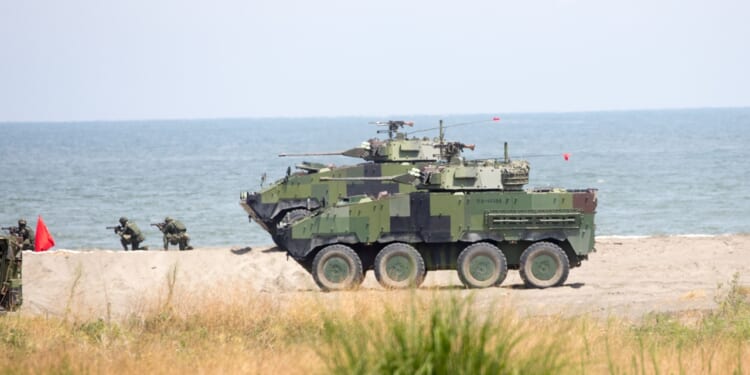Taiwan’s east coast has long been treated as an afterthought in its defense strategy—yet recent military exercises have highlighted its weak position.
Things appear bleak for the embattled island democracy of Taiwan. First, the Trump administration blocked a $400 million military aid package intended to help bolster the besieged island’s defense in the face of growing threats from Mainland China. Then, the island’s second-largest political party, the KMT, nominated a fanatically pro-China politician to its leadership. Most recently, the TTX 2025 wargame exercises held earlier this year determined that Taiwan’s eastern region could no longer serve as a strategic buffer against any Chinese invasion of their island.
Taiwan’s TTX-2025 Exercises Didn’t Go Well
Taiwan’s TTX 2025 exercises aimed to simulate how the Chinese People’s Liberation Army (PLA) would conduct critical military operations against the island. Though the exact details of such an invasion are unknown, it is easy to imagine the broad strokes. First, the PLA would capture the outlying islands under Taiwan’s nominal control. The People’s Liberation Army Navy (PLAN) would then blockade the island. After that, the Chinese military would launch sweeping attacks against Taiwan’s east coast—cities like Hualien, Taitung, and Yilan—and seize the island of Penghu.
Essentially, Taiwanese forces had always trained to effectively use the eastern region as a strategic buffer. Thanks to advances made in the development of the Chinese military, however, Taipei can no longer rely on the eastern regions to serve as a reliable buffer. Indeed, the wargame determined that the eastern coast of Taiwan is more vulnerable than previously believed.
Taiwan’s military assumptions (based on geography) are being eroded by Chinese military advances in the air and across the maritime domain. No longer can Taiwanese forces rely on the island’s central mountain range, its Western air defenses, or the sea-to-west orientation to provide Taiwan with much-needed protection. China read all these advantages and worked assiduously to degrade them. Now, Beijing has done this.
After the TTX 2025 concluded, its participants made six important recommendations. The first was for Taiwan to establish clear response guidelines and rules of engagement for grayzone provocations of the kind that China specializes in. Taiwanese forces must be extra vigilant, considering that Chinese forces could easily switch from conducting an aggressive exercise either in—or near—Taiwanese territorial region to launching a surprise attack against Taiwan.
The possibility that China intends to blockade Taiwan’s key outlying islands is real. Therefore, Taipei will need to recalibrate and enhance their long-range reinforcement strategies compared to what they are.
Another recommendation was to integrate allied support more explicitly and to regularly conduct joint navy/coast guard drills. Taiwanese overseers for the TTX 2025 wargame further outlined how an eastern relocation of their forces during a Chinese invasion scenario would be a disaster, considering how vulnerable to Chinese attack that portion of the island now is.
Lastly, the Taiwanese participants in the TTX 2025 advocate for the east coast to become the hub of effective countermeasures for a sudden attack.
Why Taiwan’s East Coast Matters
Taiwan’s central mountain range runs north-south. Historically, the assumption among Taiwanese strategists has always been that an attacker (from the Chinese mainland) would have to go west to reach Taiwan’s main military and population centers, navigate the heavy Western airspace defenses, or cross the Taiwan Strait. The east coast of Taiwan was less exposed, less heavily populated, and viewed as a fallback or less likely axis of attack.
Yet, like any good strategist, the Chinese military planners have endeavored to turn what once was a Taiwanese advantage—its far eastern portions—into a weakness. By targeting outlying islands, exploiting east coast vulnerabilities, Taiwan’s east coast defense strategy is void. And control of Taiwan’s east coast affects how maritime and air forces (belonging to China, Taiwan, and other allied states) can operate in the Western Pacific.
Originally, Taiwan’s military had viewed the east coast of the island as a quasi-sanctuary. Just the opposite has now occurred.
What really matters, of course, is how Taiwan (and allies, like those in Washington and Tokyo) will respond to these findings. Will there be a significant reallocation of key resources needed to defend Taiwan?
The landscape available to China with which to attack Taiwan has only increased. In other words, Taiwan has many more fronts their already strained forces will have to focus on should a shooting war erupt.
About the Author: Brandon J. Weichert
Brandon J. Weichert is a senior national security editor at The National Interest. Recently, Weichert became the host of The National Security Hour on America Outloud News and iHeartRadio, where he discusses national security policy every Wednesday at 8pm Eastern. He is also a contributor at Popular Mechanics and has consulted regularly with various government institutions and private organizations on geopolitical issues. Weichert’s writings have appeared in multiple publications, including The Washington Times, National Review, The American Spectator, MSN, and the Asia Times. His books include Winning Space: How America Remains a Superpower, Biohacked: China’s Race to Control Life, and The Shadow War: Iran’s Quest for Supremacy. His newest book, A Disaster of Our Own Making: How the West Lost Ukraine is available for purchase wherever books are sold. He can be followed via Twitter @WeTheBrandon.
Image: Shutterstock / jamesonwu1972.


















